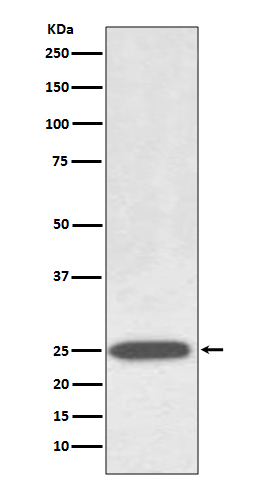
| WB | 1/500-1/1000 | Human,Mouse,Rat |
| IF | 咨询技术 | Human,Mouse,Rat |
| IHC | 1/50-1/100 | Human,Mouse,Rat |
| ICC | 1/50-1/200 | Human,Mouse,Rat |
| FCM | 咨询技术 | Human,Mouse,Rat |
| Elisa | 咨询技术 | Human,Mouse,Rat |
| Aliases | AQP1; CHIP28; Aquaporin-1; AQP-1; Aquaporin-CHIP; Urine water channel; Water channel protein for red blood cells and kidney proximal tubule |
| Entrez GeneID | 358 |
| WB Predicted band size | Calculated MW: 29 kDa; Observed MW: 29 kDa |
| Host/Isotype | Rabbit IgG |
| Antibody Type | Primary antibody |
| Storage | Store at 4°C short term. Aliquot and store at -20°C long term. Avoid freeze/thaw cycles. |
| Species Reactivity | Human,Mouse,Rat |
| Immunogen | A synthesized peptide derived from human AQP1 |
| Formulation | Purified antibody in PBS with 0.05% sodium azide. |
+ +
1. **"Aquaporin-1 water channel protein in lung: ontogeny, steroid-induced expression, and distribution"**
- **作者**: King LS, Nielsen S, Agre P
- **摘要**: 该研究利用AQP1抗体通过免疫组化和免疫印迹技术,揭示了AQP1在肺组织中的表达模式及其在激素调控下的变化,证实了AQP1在肺泡液体平衡中的作用。
2. **"Immunolocalization of the mercurial-insensitive water channel and glycerol intrinsic protein in epithelial cell plasma membranes"**
- **作者**: Nielsen S, Smith BL, Christensen EI, Agre P
- **摘要**: 通过AQP1特异性抗体进行免疫荧光定位,首次明确了AQP1在肾脏近端小管和红细胞膜中的高表达,验证了其作为水通道蛋白的生理功能。
3. **"Defective cellular trafficking of an aquaporin-1 mutant associated with human red blood cell dysosmosis"**
- **作者**: Preston GM, Smith BL, Zeidel ML, Agre P
- **摘要**: 研究采用AQP1抗体进行Western blot和流式细胞术,分析了AQP1基因突变导致的红细胞膜蛋白运输缺陷,揭示了AQP1结构与功能的关系。
4. **"Altered expression of aquaporin-1 in human gliomas and its contribution to cell migration and edema"**
- **作者**: Endo M, Jain RK, Witwer B, Brown D
- **摘要**: 通过免疫组织化学和RNA干扰实验结合AQP1抗体,发现AQP1在胶质瘤中过表达,并参与肿瘤血管生成和水肿形成,提示其作为治疗靶点的潜力。
Aquaporin 1 (AQP1) is a small transmembrane protein belonging to the aquaporin family, which facilitates selective water transport across cell membranes. Discovered in 1988. AQP1 is expressed in various tissues, including kidney proximal tubules, red blood cells, and vascular endothelia, playing a critical role in regulating osmotic balance and fluid homeostasis. As the first identified water channel, its structure—a tetramer with individual monomers forming pores—has been extensively studied, providing insights into passive water permeability mechanisms.
Antibodies targeting AQP1 are essential tools for studying its expression, localization, and function. These antibodies are typically raised in hosts like rabbits or mice using immunogenic peptides derived from conserved regions of the human or rodent AQP1 protein. They enable detection via techniques such as immunohistochemistry, Western blotting, and flow cytometry. AQP1 antibodies have been pivotal in research linking the protein to physiological processes (e.g., urine concentration, cerebrospinal fluid production) and pathologies, including edema, cancer angiogenesis, and renal disorders. Commercial AQP1 antibodies are often validated for specificity using knockout controls or siRNA-mediated silencing. However, variability in antibody performance across species or experimental conditions necessitates careful validation. Recent studies also explore AQP1's role in cell migration and tumor progression, highlighting the continued relevance of these reagents in biomedical research.
×